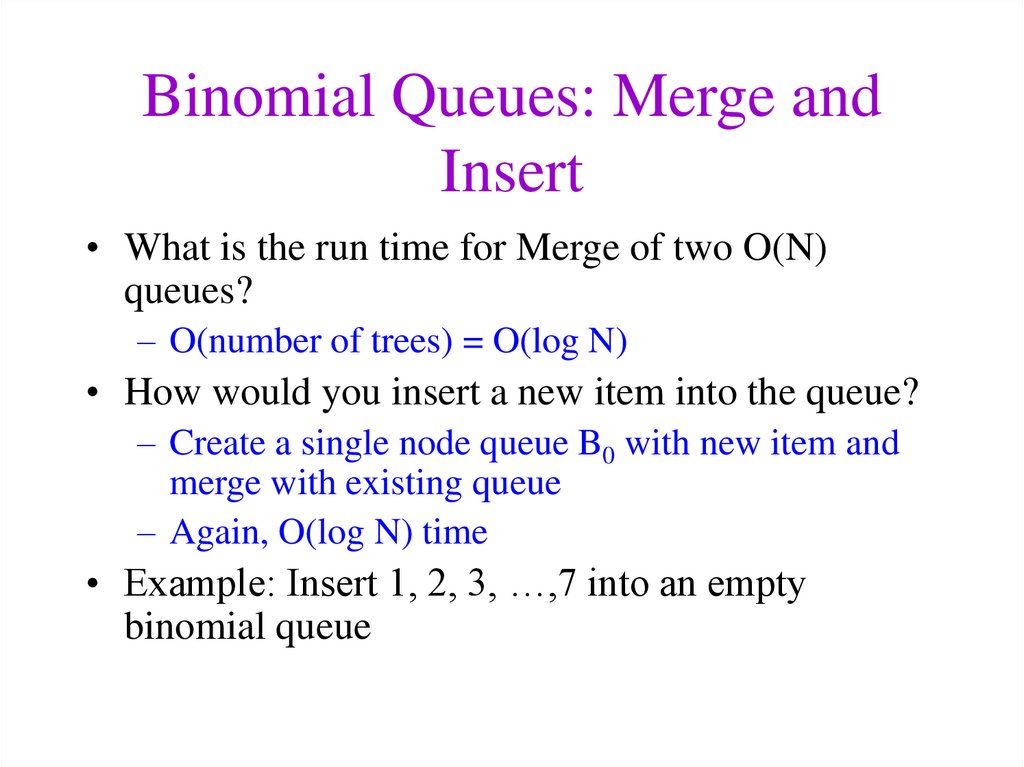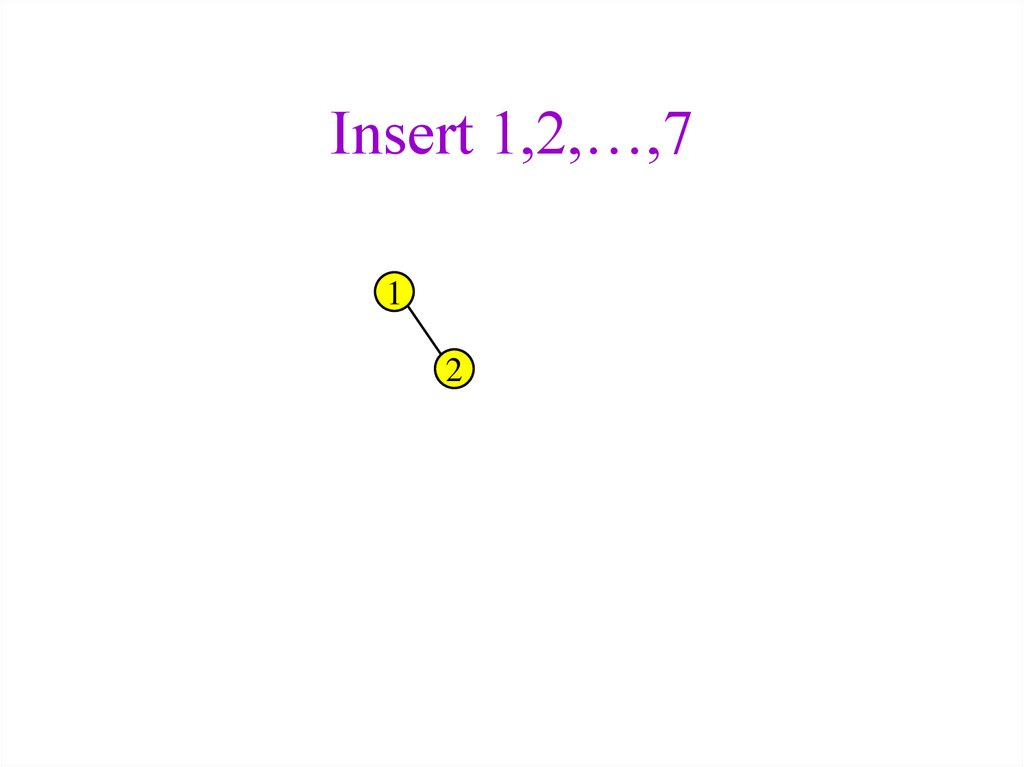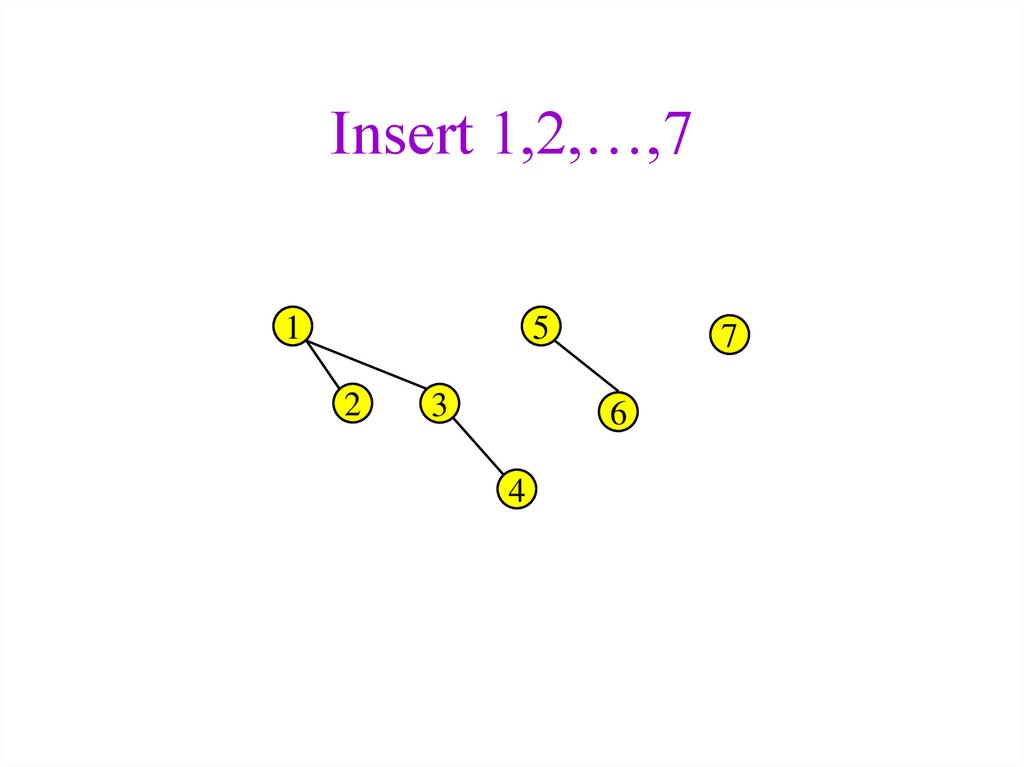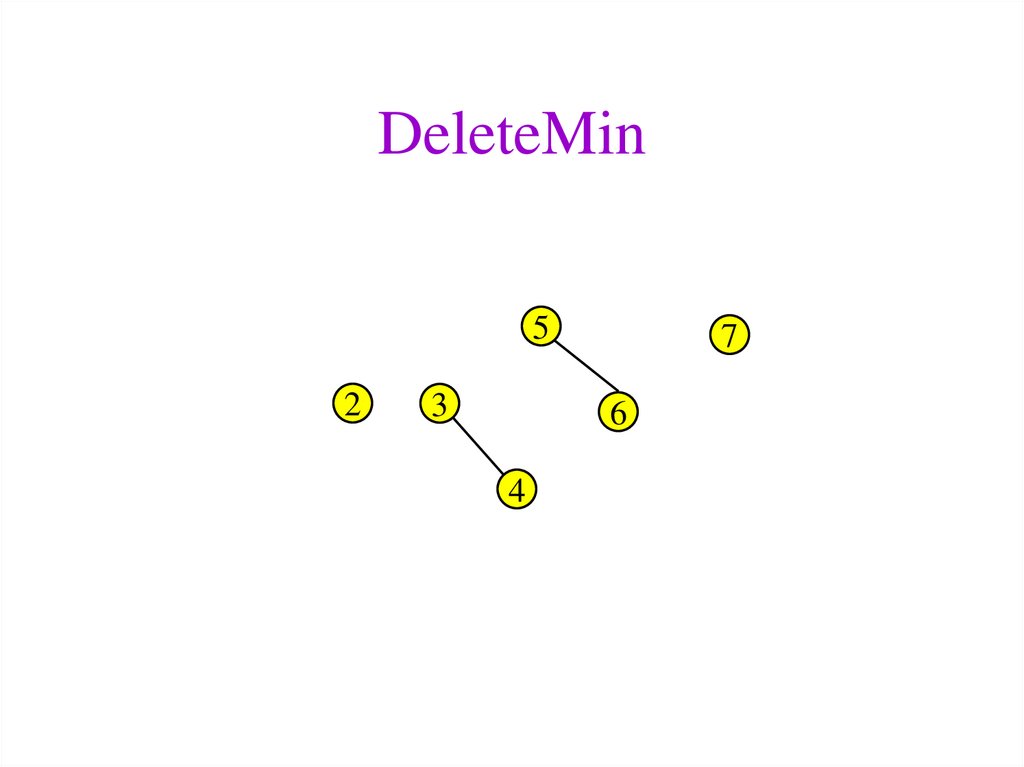Similar presentations:
CSE 326: Data Structures. Mergeable Heaps. Lecture #22
1. CSE 326: Data Structures Lecture #22 Mergeable Heaps
Henry KautzWinter Quarter 2002
2. Summary of Heap ADT Analysis
• Consider a heap of N nodes• Space needed: O(N)
– Actually, O(MaxSize) where MaxSize is the size of the array
– Pointer-based implementation: pointers for children and parent
• Total space = 3N + 1 (3 pointers per node + 1 for size)
• FindMin: O(1) time; DeleteMin and Insert: O(log N) time
• BuildHeap from N inputs: What is the run time?
– N Insert operations = O(N log N)
– O(N): Treat input array as a heap
and fix it using percolate down
• Thanks, Floyd!
3. Other Heap Operations
• Find and FindMax: O(N)• DecreaseKey(P, ,H): Subtract from current key value at
position P and percolate up. Running Time: O(log N)
• IncreaseKey(P, ,H): Add to current key value at P and
percolate down. Running Time: O(log N)
– E.g. Schedulers in OS often decrease priority of CPU-hogging jobs
• Delete(P,H): Use DecreaseKey (to 0) followed by
DeleteMin. Running Time: O(log N)
– E.g. Delete a job waiting in queue that has been preemptively
terminated by user
4. But What About...
Merge(H1,H2): Merge two heaps H1 and H2 of size
O(N).
– E.g. Combine queues from two different sources to run on one
CPU.
1. Can do O(N) Insert operations: O(N log N) time
2. Better: Copy H2 at the end of H1 (assuming array
implementation) and use Floyd’s Method for
BuildHeap.
Running Time: O(N)
Can we do even better? (i.e. Merge in O(log N) time?)
5. Binomial Queues
• Binomial queues support all three priority queue operationsMerge, Insert and DeleteMin in O(log N) time
• Idea: Maintain a collection of heap-ordered trees
– Forest of binomial trees
• Recursive Definition of Binomial Tree (based on height k):
– Only one binomial tree for a given height
– Binomial tree of height 0 = single root node
– Binomial tree of height k = Bk = Attach Bk-1 to root of
another Bk-1
6. Building a Binomial Tree
To construct a binomial tree Bk of height k:
1. Take the binomial tree Bk-1 of height k-1
2. Place another copy of Bk-1 one level below the first
3. Attach the root nodes
Binomial tree of height k has exactly 2k nodes (by induction)
B0
B1
B2
B3
7. Building a Binomial Tree
To construct a binomial tree Bk of height k:
1. Take the binomial tree Bk-1 of height k-1
2. Place another copy of Bk-1 one level below the first
3. Attach the root nodes
Binomial tree of height k has exactly 2k nodes (by induction)
B0
B1
B2
B3
8. Building a Binomial Tree
To construct a binomial tree Bk of height k:
1. Take the binomial tree Bk-1 of height k-1
2. Place another copy of Bk-1 one level below the first
3. Attach the root nodes
Binomial tree of height k has exactly 2k nodes (by induction)
B0
B1
B2
B3
9. Building a Binomial Tree
To construct a binomial tree Bk of height k:
1. Take the binomial tree Bk-1 of height k-1
2. Place another copy of Bk-1 one level below the first
3. Attach the root nodes
Binomial tree of height k has exactly 2k nodes (by induction)
B0
B1
B2
B3
10. Building a Binomial Tree
To construct a binomial tree Bk of height k:
1. Take the binomial tree Bk-1 of height k-1
2. Place another copy of Bk-1 one level below the first
3. Attach the root nodes
Binomial tree of height k has exactly 2k nodes (by induction)
B0
B1
B2
B3
11. Building a Binomial Tree
To construct a binomial tree Bk of height k:
1. Take the binomial tree Bk-1 of height k-1
2. Place another copy of Bk-1 one level below the first
3. Attach the root nodes
Binomial tree of height k has exactly 2k nodes (by induction)
B0
B1
B2
B3
12. Building a Binomial Tree
To construct a binomial tree Bk of height k:
1. Take the binomial tree Bk-1 of height k-1
2. Place another copy of Bk-1 one level below the first
3. Attach the root nodes
Binomial tree of height k has exactly 2k nodes (by induction)
B0
B1
B2
B3
13. Why Binomial?
• Why are these trees called binomial?– Hint: how many nodes at depth d?
B0
B1
B2
B3
14. Why Binomial?
• Why are these trees called binomial?– Hint: how many nodes at depth d?
Number of nodes at different depths d for Bk =
[1], [1 1], [1 2 1], [1 3 3 1], …
Binomial coefficients of (a + b)k = k!/((k-d)!d!)
B0
B1
B2
B3
15. Definition of Binomial Queues
Binomial Queue = “forest” of heap-ordered binomial treesB0 B2
B0
B1
B3
3
21
1
-1
5
7
9 6
7
Binomial queue H1
5 elements = 101 base 2
B2 B0
2
3
1
8
11 5
Binomial queue H2
11 elements = 1011 base 2
B3 B1 B0
6
16. Binomial Queue Properties
Suppose you are given a binomial queue of N nodes1. There is a unique set of binomial trees for N nodes
2. What is the maximum number of trees that can be in
an N-node queue?
–
1 node 1 tree B0; 2 nodes 1 tree B1; 3 nodes 2 trees
B0 and B1; 7 nodes 3 trees B0, B1 and B2 …
– Trees B0, B1, …, Bk can store up to 20 + 21 + … + 2k =
2k+1 – 1 nodes = N.
– Maximum is when all trees are used. So, solve for (k+1).
– Number of trees is log(N+1) = O(log N)
17. Binomial Queues: Merge
• Main Idea: Merge two binomial queues by mergingindividual binomial trees
– Since Bk+1 is just two Bk’s attached together, merging
trees is easy
• Steps for creating new queue by merging:
1. Start with Bk for smallest k in either queue.
2. If only one Bk, add Bk to new queue and go to next
k.
3. Merge two Bk’s to get new Bk+1 by making larger
root the child of smaller root. Go to step 2 with k =
k + 1.
18. Example: Binomial Queue Merge
• Merge H1 and H2H1:
3
H2:
21
5
-1
1
7
9 6
7
2
3
1
8
11 5
6
19. Example: Binomial Queue Merge
• Merge H1 and H2H1:
H2:
3
21
-1
1
5
7
9 6
7
2
3
1
8
11 5
6
20. Example: Binomial Queue Merge
• Merge H1 and H2H1:
H2:
3
21
-1
1
5
7
9 6
7
2
3
1
8
11 5
6
21. Example: Binomial Queue Merge
• Merge H1 and H2H1:
H2:
1
5
-1
7
9 6
7
3
2
21
3
1
8
11 5
6
22. Example: Binomial Queue Merge
• Merge H1 and H2H1:
H2:
1
5
-1
7
9 6
7
3
2
21
3
1
8
11 5
6
23. Example: Binomial Queue Merge
• Merge H1 and H2H1:
H2:
-1
1
7
5
3
21
2
9 6
3
1
8
7
11 5
6
24. Example: Binomial Queue Merge
• Merge H1 and H2H1:
H2:
-1
1
7
5
3
21
2
9 6
3
1
8
7
11 5
6
25. Example: Binomial Queue Merge
• Merge H1 and H2H1:
H2:
-1
2
1
3
1
8
7
11 5
6
5
3
21
9 6
7
26. Example: Binomial Queue Merge
• Merge H1 and H2H1:
H2:
-1
2
1
3
1
8
7
11 5
6
5
3
21
9 6
7
27. Binomial Queues: Merge and Insert
• What is the run time for Merge of two O(N)queues?
• How would you insert a new item into the queue?
28. Binomial Queues: Merge and Insert
• What is the run time for Merge of two O(N)queues?
– O(number of trees) = O(log N)
• How would you insert a new item into the queue?
– Create a single node queue B0 with new item and
merge with existing queue
– Again, O(log N) time
• Example: Insert 1, 2, 3, …,7 into an empty
binomial queue
29. Insert 1,2,…,7
130. Insert 1,2,…,7
12
31. Insert 1,2,…,7
31
2
32. Insert 1,2,…,7
31
2
4
33. Insert 1,2,…,7
12
3
4
34. Insert 1,2,…,7
15
2
3
4
35. Insert 1,2,…,7
15
2
3
6
4
36. Insert 1,2,…,7
15
2
3
7
6
4
37. Binomial Queues: DeleteMin
• Steps:1. Find tree Bk with the smallest root
2. Remove Bk from the queue
3. Delete root of Bk (return this value); You now have a
new queue made up of the forest B0, B1, …, Bk-1
4. Merge this queue with remainder of the original (from
step 2)
• Run time analysis: Step 1 is O(log N), step 2 and 3 are
O(1), and step 4 is O(log N). Total time = O(log N)
• Example: Insert 1, 2, …, 7 into empty queue and
DeleteMin
38. Insert 1,2,…,7
15
2
3
7
6
4
39. DeleteMin
52
3
7
6
4
40. Merge
52
3
7
6
4
41. Merge
52
3
7
6
4
42. Merge
52
6
7
3
4
43. Merge
52
6
7
3
4
DONE!
44. Implementation of Binomial Queues
• Need to be able to scan through all trees, and giventwo binomial queues find trees that are same size
– Use array of pointers to root nodes, sorted by size
– Since is only of length log(N), don’t have to worry
about cost of copying this array
– At each node, keep track of the size of the (sub) tree
rooted at that node
• Want to merge by just setting pointers
– Need pointer-based implementation of heaps
• DeleteMin requires fast access to all subtrees of root
– Use First-Child/Next-Sibling representation of trees
45. Other Mergeable Priority Queues: Leftist and Skew Heaps
• Leftist Heaps: Binary heap-ordered trees with left subtreesalways “longer” than right subtrees
– Main idea: Recursively work on right path for Merge/Insert/DeleteMin
– Right path is always short has O(log N) nodes
– Merge, Insert, DeleteMin all have O(log N) running time (see text)
• Skew Heaps: Self-adjusting version of leftist heaps (a la splay
trees)
– Do not actually keep track of path lengths
– Adjust tree by swapping children during each merge
– O(log N) amortized time per operation for a sequence of M operations
• We will skip details… just recognize the names as mergeable
heaps!
46. Coming Up
• Some random randomized data structures– Treaps
– Skip Lists
– FOR MONDAY: Read section on randomized data
structures in Weiss. Be prepared, if called on, to
explain in your own words why we might want to use a
data structure that incorporates randomness!














































 programming
programming








